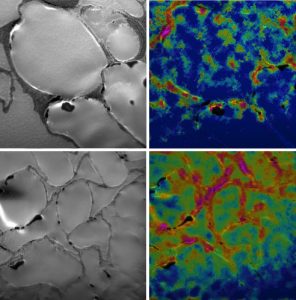Dubbed ‘forever chemicals’, PFAS are chemicals used in a large range of applications from non-stick cookware to fire-fighting foam. They take decades to breakdown and accumulate in animals, humans and the environment. PFAS stands for Per- and poly-fluoroalkyl substances. They are man-made chemicals that are so pervasive that 97% of Americans have some level of PFAS in their blood. An association has been observed between elevated levels of PFAS in the blood and increased cholesterol, poor kidney function, and certain types of cancer (ANU PFAS Epidemiological Study).
Because of the potential health impacts of these chemicals there is a lot of interest in developing new solutions for removing them from our environment. As we’ve previously reported, Microscopy Australia’s facilities have been used in the development of several products that can adsorb PFAS. They include polymer sponges, nanostructured graphene and oil capsules. However, Dr John Awad and his colleagues at the University of South Australia, have taken a different approach, investigating if wetland plants, rather than a manufactured product, might be able to do the same job.
Reeds are widely used to purify water and the team experimented with growing several Australian wetland grasses, hydroponically in PFAS-contaminated stormwater. The amount of PFAS absorbed by these plants was then measured. The NanoSIMS at Microscopy Australia’s University of Western Australia facility, the Centre for Microscopy, Characterisation and Analysis, was used to observe where radioactively tagged PFAS was accumulating. They found it was taken up by the plant, rather than just attaching to the surface, and that different PFAS types collected preferentially in either the roots or the shoots.

Scanning electron microscope (left) and Nano-SIMS images (right) showing PFAS accumulation (redder shades) in the outer regions of leaf (top) and root (bottom) cells.
All the plants tested removed PFAS from the storm water but the common reed, Phragmites australis, was the most effective. These findings validate the potential use of constructed floating wetlands (CFWs), using plants such as the common reed, in buoyant structures where pollutants are assimilated into plant biomass, which can then be removed. The team are now testing these CFWs to see how effectively they can remove PFAS from contaminated water in real-world conditions.
Once the plants have taken up as much PFAS as possible, they could be harvested and incinerated at high temperatures to remove the PFAS, leaving agriculturally useful biochar as the end product.
Constructed floating wetlands that could be used for PFAS removal
July 27, 2022